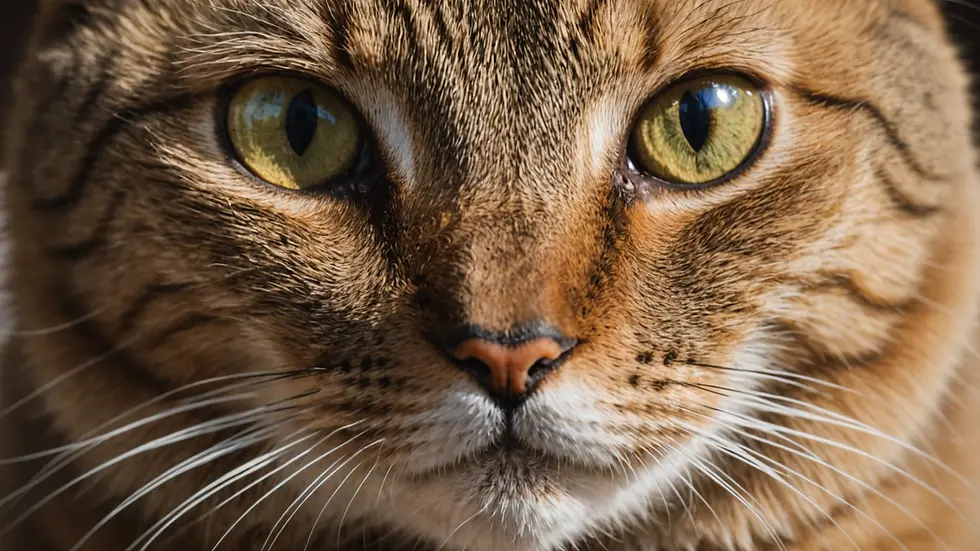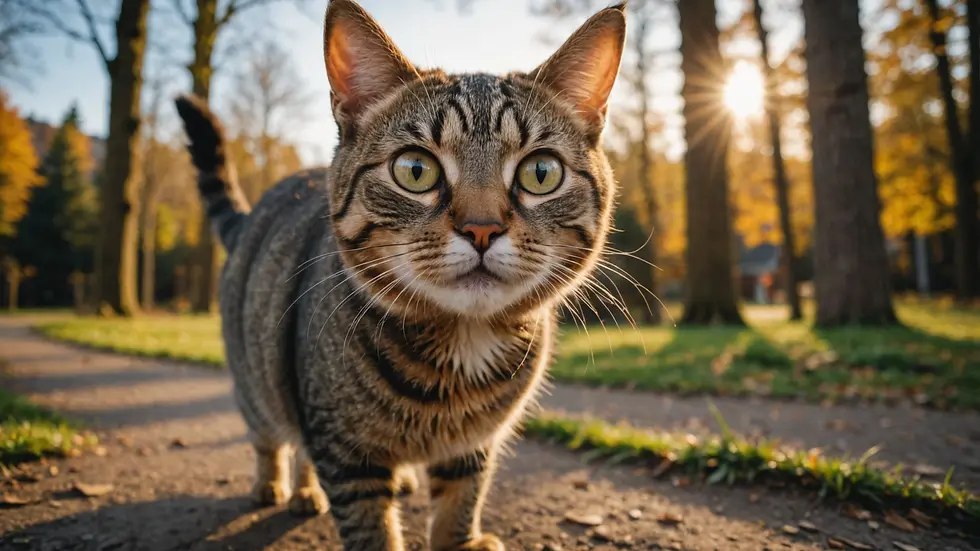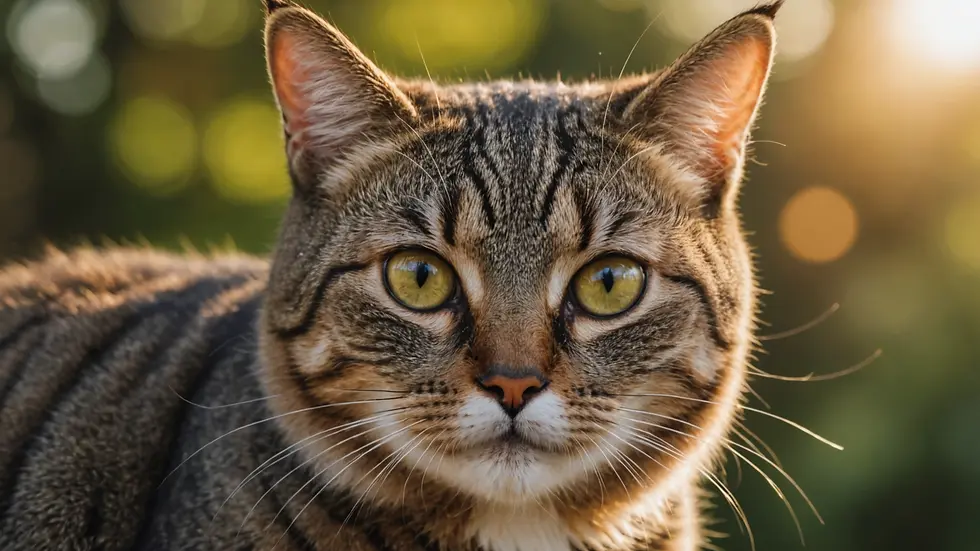Why Do Cats Have Whiskers? Exploring the Mysterious Purpose of Feline Facial Hair
- Jyotiraj Borah
- Feb 5
- 4 min read
Cats are remarkable creatures, and their whiskers are among the most distinctive features they possess. These long, sensitive hairs, known as vibrissae, are not just for show. They play a vital role in a cat's everyday life and overall well-being. In this post, we will explore the purpose of whiskers, how they function, and why they are essential for our feline friends.
What Are Whiskers?
Whiskers are specialized hairs located on a cat's face and are crucial for various purposes. These hairs are thicker and longer than regular fur, making them easy to spot. Depending on the cat's breed and individual characteristics, whiskers typically extend about as wide as their body.
Deeply embedded in the skin, whiskers connect to a rich network of nerves. This setup allows them to detect even the faintest changes in their environment. Their sensitivity makes whiskers an invaluable tool for a cat's navigation and interaction with the world.
The Functionality of Whiskers
Whiskers carry out several essential tasks that greatly influence a cat's survival and day-to-day activities.
1. Spatial Awareness
A primary function of whiskers is to assist in spatial awareness. Cats measure the width of openings by using their whiskers. For instance, when a cat approaches a narrow gap, it can determine if it can fit through based on its whiskers. This function helps prevent accidents and allows for safer navigation.
2. Environmental Exploration
Whiskers are highly sensitive to touch and vibrations, enabling cats to explore their environments with confidence. For example, when a cat enters a new room, its whiskers help assess nearby items, detect movement, and sense air currents. Such tactile feedback fosters a deeper understanding of their surroundings, leading to more confidence.
3. Hunting and Prey Detection
Whiskers play a crucial role in a cat's hunting abilities. For instance, when stalking a mouse, a cat relies on its whiskers to perceive even the slightest movements. If a rodent rustles nearby, its whiskers pick up vibrations, alerting the cat to its presence. Moreover, when a cat captures its prey, whiskers help determine the size and position, proving invaluable when hunting in low-light conditions.
4. Communication
Beyond being sensory tools, whiskers also aid feline communication. The position of a cat’s whiskers can provide insight into their mood. For instance, whiskers that point forward might indicate curiosity or aggression, while whiskers held back can signify fear or submission. Recognizing these subtle signals can enhance the bond between cats and their owners.

Whiskers and Their Sensory Capabilities
The remarkable sensory capabilities of whiskers come from their unique structure. Each whisker consists of a protein called keratin, similar to our hair and nails. What makes whiskers special is their connection to a rich vascular system and numerous nerve endings.
1. Sensitivity to Touch
Each whisker’s nerve endings are incredibly sensitive. When a whisker brushes against an object, it sends signals to the cat's brain. This helps cats gather information about the object’s texture, whether it is rough or smooth. Such feedback allows cats to make informed decisions during exploration.
2. Response to Vibrations
Whiskers excel at detecting vibrations in the air. This ability is particularly useful during hunts or when assessing potential threats. For example, in a quiet room, a tiny movement can be detected through whiskers, alerting the cat to nearby creatures. This sensitivity can determine whether a cat chooses to approach or retreat.
3. Navigating in the Dark
As crepuscular animals, cats are most active at dusk and dawn. Whiskers play a crucial role in their nighttime navigation. Their heightened sensitivity ensures that cats can confidently move around in low-light conditions, whether they're hunting or avoiding predators.

The Importance of Maintaining Whiskers
Whiskers are vital for a cat's health, so proper care is essential. Unlike fur, which regrows when clipped, whiskers do not regenerate the same way due to their sensitivity.
1. Avoiding Whisker Stress
Many cat owners overlook whisker stress, where cats feel discomfort if their whiskers constantly touch the sides of a bowl. To prevent this, using shallow dishes can help cats eat and drink comfortably without excessive whisker contact, ensuring they enjoy their meals.
2. Understanding Whisker Loss
If a cat is losing whiskers, it could indicate stress or potential health issues. Factors such as changes in routine or diet can affect whiskers. Monitoring any alterations in behavior or physical condition is crucial for early detection of problems. In fact, a study found that about 60% of cats show behavioral changes when experiencing environmental stress.
Myths Surrounding Cat Whiskers
There are various myths about whiskers that deserve clarification. Understanding the truth can enhance cat owners' knowledge of their pets.
1. Whiskers Are Just for Show
Contrary to this common misconception, whiskers are vital tools for navigation, hunting, and communication.
2. Cutting Whiskers Doesn't Affect Cats
Some believe trimming whiskers is harmless. In reality, cutting whiskers can disorient cats, leading to stress and confusion as they rely heavily on these sensory tools for safe navigation.
3. All Cats Have the Same Whisker Length
Not all cats have the same whisker length. Larger breeds, such as Maine Coons, may have whiskers up to four inches long, while smaller breeds like Singapura may have shorter ones. This variation enhances their ability to adapt to different environments.

Embracing the Mystery of Whiskers
Whiskers are more than striking facial features; they are essential for a cat's ability to navigate its world, hunt, and communicate. As cat owners, we must recognize the importance of whiskers to enhance our appreciation for these remarkable animals.
By ensuring that our furry companions' whiskers remain intact and free from stress points, we help support their well-being. Understanding the significance of whiskers enriches the experience of being a cat owner, enabling us to provide the best care possible while deepening our bond with these beloved pets.




Comments